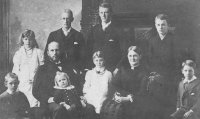 |
The History of the Ryburns -: AYRSHIRE, SCOTLAND :- |
| Home | Variations | Ayrshire | Kintyre | Ireland | Americas | Au & NZ | Sources | Links | DNA |
|
To the best of my knowledge, all present-day Ryburns are descended from an obscure family of landed gentry, who
in medieval times lived near Dunlop Village in Ayrshire,
Scotland. They were minor Scottish 'Lairds'. Fullarton's 1858 book on the history of Ayrshire had this to say about them :-
Ayrshire is a part of Scotland that lies southwest of Glasgow, and includes towns such as Ayr, Kilmarnock and Irvine. On Timothy Pont’s early maps of Scotland there are several places in the Parish of Dunlop, Northeast Ayrshire (old district of Cunninghame), whose names started with the word ‘Temple’. These were the old ‘temple lands’ that in feudal times belonged to the Knights Templar, who were disbanded in 1312. These included ‘Templeton’, ‘Tempelhous’, ‘Temple Hapland’ and ‘Temple Rÿburn’. In the early 1600s Temple Ryburn was one 'merk' in extent, or about 200 acres. A merk (mark) was an old unit of Scottish currency. Pont wrote in about 1600 :-
Traces of what was probably the old Ryburn Manor can be seen in the Google Earth images dated 14 Oct., 2002 (as illustrated) and located as on General Roy's map of 1747-55. Ryburn Manor lay 1 km east-north- east of Dunlop Church, on the south side of Newmill Road, which trends northeast out of Dunlop. The old manor house was demolished some time before 1851, and 'Ryeburn' farmhouse was built some 400 metres to the northwest. Between 1851 and 1872 the farmer there was a John Robertson. In about 1876, 'Ryeburn' was renamed 'Hapland'. The earliest record of an Ayrshire Ryburn was a Robert Ryburn, who in 1496 witnessed an 'Instrument of Sasine given by a noble knight, Sir Adam Mure, of Caldwell [Castle], near Lugton. At one stage the Mures were reputed to be the wealthiest family in Scotland. Other references were mostly to spelling variants like 'Rayburn' and 'Raeburn', and are therefore suspect. A possible exception was a 'Gilbert Ryburne', who in 1503 was a burgess in Aberdeen. In 1587-90, a ‘Jonet Ryburne’ was spouse to Robert Heygait of ‘Chapelhous’, just west of Temple Rÿburn,. We also know from four early 17th century 'Ryburne' testaments in ScotlandsPeople that there were Ryburns in Glasgow about this time. In the 16th century the Ryburns were caught up in a centuries-long feud between the Cunninghams, under the Earl of Glencairn, and the Mures, Sempills and Montgomeries - the last-mentioned lead by the Earl of Eglinton. The feud had started in about 1448, when the King unwisely transferred the baillieship of Cunninghame, long held by the Earls of Glencairn, to the Earls of Eglinton. Anderson W., 1862, 'The Scottish Nation', v1, p746, notes the first known Ryburn involvement (also noted as "John Raeburn of that Ilk" in another source) :-
However, this John Ryburn, who was perhaps my g x 9 grandfather, was in 1571 killed in revenge by Sir John Mure's eldest son Robert, who had become Laird of Caldwell on the death of his father :-
To no avail, as Sir Robert Mure was still Laird of Caldwell when he died in 1617. He was "on terms of great intimacy and confidence with James VI" of Scotland, who knighted him. The next incident was in 1586 - the infamous Murder at the Annick Ford. Hugh Montgomery, the 4th Earl of Eglinton, was brutally killed by a band of 34 Cunninghams and followers. One of the followers was another 'Johne Reyburne of that Ilk', probably the son and heir of the John murdered in 1571. The revenge of the Montgomeries that inevitably ensued was extensive, prolonged and bloody. Ryburns could well have been killed, although a 'Johne Ryburne' next appears in 1589 in an unrelated arbitration case in Renfrew, near Glasgow. The feuding continued, for in 1603 'Johne Ryburne of that Ilk' was outlawed for ignoring a summons accusing him of adultery and child murder. This John was probably the same one as in 1586. The charge was almost certainly false, as it was brought by Robert Montgomery, who was the Laird of 'Hesfilheid' (Hessilhead) from 1602 to 1623. This was typical of the numerous acts of revenge that were perpetrated by the Montgomeries at the time. Many victims fled to Ireland :-
'Put to the Horne' means to be outlawed. In Scotland the messenger-at- arms goes to the Cross of Edinburgh and gives three blasts on a horn before he heralds the judgment of outlawry. This 'Johne Ryburne' probably fled to Ireland, for in 1629 there was a court case in Edinburgh that revealed 'Ryburn' was living in Ireland when his lands were taken from him by the Laird of 'Hysleheade', Robert Montgomerie. :-
The wording suggests it was the outlawed and presumably pardoned John Ryburn who brought the case against the Laird of Hessihead. The words 'pessima fide' - the opposite of 'bona fide' - imply Montgomerie had forged the inheritance ownership papers ('precept of clair constat'). Ryburn must have succeeded in retrieving his property, for in 1638 the 'said merk-land' was sold by Neil Ryburn (perhaps John Ryburn's son) to Gabriel Porterfield of Hapland. 'Temple Hapland' had long been next door to Temple Ryburn :-
Under an old system of land measurement the '13s. 4d.' was the same as one merk of land -- it was not the purchase price. This disposal of the old Ryburn lands was a likely consequence of the history of trouble the Ryburns had experienced in lawless Ayrshire. It presaged the migration in about 1650 of a John Ryburn (possibly Neil Ryburns eldest son) and perhaps other Ryburns, to join the Maquis of Argyll's plantation scheme in Kintyre. Other related Ryburns were probably living in Ireland at the time, but some Ryburns remained in Ayrshire. In the early days of the Kintyre plantation the ‘plantationers’ used to return to Ayrshire each year to participate in communion and baptize their bairns. In 1651 a James Ryburn or Reyburn (possibly a brother of John and son of Neil Ryburn) was living in Poland along with many other Scots. They were listed as having payed a 10% tax for the "1651 Polish Subsidy to the Exiled Charles II" (Bajer, P. P., 2012, Scots in the Polish-Lithuanian Commonwealth, 16th-18th Centuries, p367). This James could be the same one that married Katrein Baird before 1646 (see below). Donald Ryburn of Lakeland, Florida, reports that the Dick Institute in Kilmarnock has records of a number of Ryburns (or Reyburns) living in Kilmarnock, Ayr and Dalry in the 17th century. These Ryburns were said to be a ‘sept of Clan Boyd’. The earliest known baptism in Kilmarnock was James, 12 April 1646 -- his parents being James "Ryburne" and Katrein Baird. They appear to be the ancestors of Robert Reyburn, who migrated to New Zealand. The Dunlop parish registers only go back to 1700, and those prior to 1780 “were very irregularly kept”, so we know little of any Ryburns there after Neil Ryburn in 1638. Ayrshire historian R. Griffith says that some Ryburn associates were “no doubt Jacobites – the MacAlisters of Kennox, for instance”. This suggests that some Ryburns were Jacobites as well. A James Ryburn who was a bonnet maker in Stewarton in 1705 was probably the same one fined by a court in Stewarton in 1707 for fighting and 'cutting others [hat] feathers' :-
Scotland'sPeople website has many 18th-century Ryburn or 'Reyburn' births and marriages in Stewarton and Kilmarnock. By the first census in 1841 there were Ryburns as handloom weavers, bonnet makers, carpet weavers, sewers, and knitters in Stewarton and Kilmarnock. In about 1820 a James Ryburn became a shoe maker in Largs. His descendants now live in Glasgow and Aberdeen. A family of 'Reyburns' from Stewarton emigrated to Illinois, USA, mid- 19th century, and were thereafter known as Ryburns. Youngest son Charles was a 'forty niner' in California, then in Victoria, Australia. He was the first Ryburn in Australasia, but he died in Melbourne in 1854, without issue. A Robert Reyburn, born in Kilmarnock in 1810 to a John Reyburn, bonnet maker, emigrated to New Zeasland in 1859 and settled in Whangarei. No doubt other Ayrshire Ryburns also emigrated. Last updated 19 Aug, 2014. |
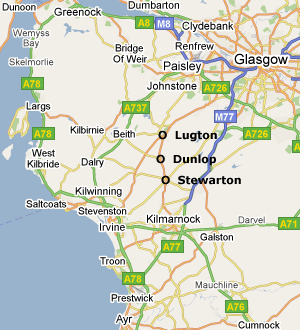 Location of Dunlop in Northeast Ayrshire. 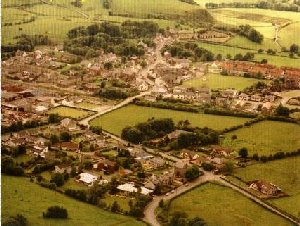 Aerial photo of Dunlop Village, Ayrshire 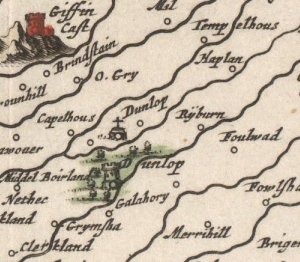
Location of 'Rÿburn' on Blaeu's Map of 1654, based
on Pont's 1604 map, which shows 'Temple Ryburn'.
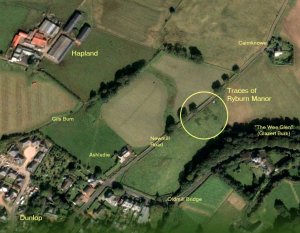 Probable traces of the old Ryburn Manor House, Dunlop, Ayrshire. 2002 image in Google Earth. Click to enlarge. 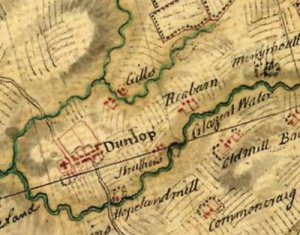 'Reaburn', as shown on General Roy's Map, 1747-55. 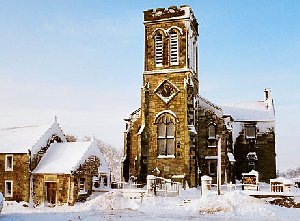 Dunlop Church, built in 1835. 1st Protestant minister of the old church was Hans Hamilton, 1536 - 1608. 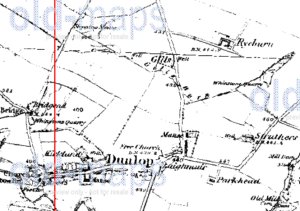 'Ryeburn' Farmhouse, on the 1858 Ordinance Survey map. Click to enlarge. 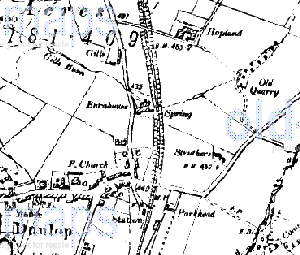 1897 Ordinance Survey map showing 'Hapland' in place of 'Ryeburn' on the 1858 map. Note railway. 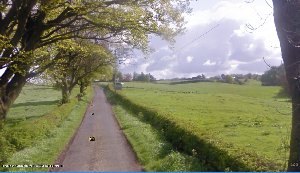 Site of the old Ryburn Manor House is on the south- east side of Newmill Road, 1km east-north-east of Dunlop Church. Photo courtesy Google Street View. 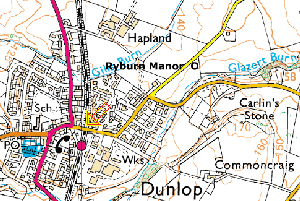 Location of the old Ryburn Manor House near Dunlop. Map courtesy Streetmap.co.uk. Click to enlarge. 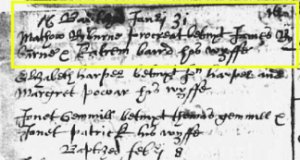 Early Ryburn baptismal record in Kilmarnock, 31 Jan 1649, Mathew Ryburne, son of James Ryburne and Katrein Baird. Courtesy www.scotlandspeople.gov.uk. |